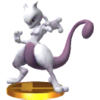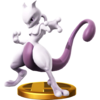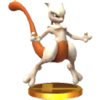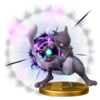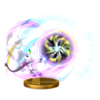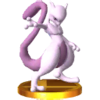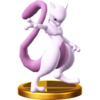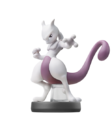Mewtwo (SSB4)
| Mewtwo in Super Smash Bros. 4 | |
|---|---|
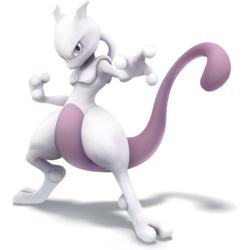 
| |
| Universe | Pokémon |
| Other playable appearances | in Melee in Ultimate |
| Availability | Downloadable |
| Final Smash | Psystrike |
| Tier | A (10) |
| “ | Mewtwo Strikes Back! | ” |
| —Introduction Tagline | ||
Mewtwo (ミュウツー, Mewtwo) is a playable character in Super Smash Bros. 4. Its return to the series (erroneously calling it a "new fighter") was announced during the Super Smash Bros. for Wii U 50-Fact Extravaganza on October 23rd, 2014.[1] Mewtwo is the first downloadable character in Super Smash Bros. history, and was made available on April 28th, 2015.[2] However, it was made available at no cost as early as April 15th, 2015 for players who registered both Super Smash Bros. for Nintendo 3DS and Super Smash Bros. for Wii U on Club Nintendo by March 31st, 2015.[2][3]
Rather than retaining Masachika Ichimura as its voice actor from Melee, Mewtwo is now voiced by Keiji Fujiwara, who imitates some of the former's voice clips from Melee.
Mewtwo is ranked 10th out of 54 on the tier list, placing it in the A tier. This is a huge improvement from its low-tier placement in Melee, where it was ranked 20th out of 26, and its best placement in the series to date. Mewtwo boasts excellent mobility, featuring above-average air, walking and dashing speeds. Mewtwo also possesses a flexible combo game: its neutral attack is a very reliable jab cancel, even at high percentages, while its down tilt and fast falling up aerial both possess a variety of follow-ups at low to high percentages. In addition, Mewtwo features a strong set of throws, with its forward throw being tied for the most damaging throw of its kind in the game, whereas its back and up throws are viable KOing options. Alongside the latter, Mewtwo also boasts a respectable number of other strong moves that possess considerable power, including its smash attacks, forward aerial, and fully charged Shadow Ball. Finally, its airdodge causes it to disappear completely and is the fastest one in the game, making it quite spammable.
However, Mewtwo also has several notable weaknesses. The biggest weakness is its fragility, as Mewtwo's tall stature and very light weight makes it easier to KO compared to most of the cast. This, in turn, is compounded by Mewtwo's slightly below-average frame data and slow double jump, which forces it to rely on its neutral aerial, forward aerial, or Teleport to escape pressure more often than not.
After initially being a poorly perceived character upon its release, game updates significantly improved Mewtwo's viability over time. This has been reflected by players such as Abadango, Rich Brown, and WaDi consistently achieving high placings in competitive play, whose successes have helped Mewtwo achieve top-tier status since the game's second tier list.
Attributes[edit]
Mewtwo is a character whose majority of attributes are unusually polarizing, with only its falling speed and gravity being average. It is tall, yet is the second lightest character in the game, being surpassed only by Jigglypuff. By extension, Mewtwo's hurtbox has a deceptive size: although it is larger than in Melee, its model's adjusted z-axis position has resulted in its hurtbox ending approximately at its digits, ankles, and the base of its tail.[4][5] As a result, the majority of Mewtwo's tail now lacks hurtboxes unlike in Melee, which makes all but the base of its tail immune to opposing hitboxes. However, its hurtbox will still extend slightly when it attacks, whereas its digits, ankles, and the base of its tail will leave their z-axis positions when it is in hitstun or while tumbling.[4]
In regard to grounded mobility, Mewtwo's walking speed is tied with Charizard's for the fifteenth fastest in the game, whereas its dashing speed is the seventh fastest in the game. However, its traction is also tied with Charizard's for the second lowest in the game. This polarization is also apparent with Mewtwo's aerial mobility: its air speed is the third fastest in the game, yet it has slow air acceleration, while its double jump is the highest in the game, yet accelerates slowly at its beginning. As a result of these attributes, landing and approaching safely can be difficult. Unlike in Melee, Mewtwo is capable of wall jumping.
Mewtwo's air game is highly potent. Its air dodge makes it disappear briefly and is the fastest one in the game, thanks to it concluding after 28 frames. Mewtwo's aerial moves boast impressive power thanks to their respectable damage outputs and very high knockback scaling, yet are also useful for partaking in combos. Neutral aerial's hitbox has a long duration, which allows it to punish air dodges or start combos upon landing as the opponent is being hit. Forward aerial is Mewtwo's fastest aerial, thanks to it hitting on frame 6. When coupled with its power and range, it can either combo into itself at low percentages, or KO outright at high percentages.
Back aerial has very large range, which enables it to edge-guard reliably, yet also combo into itself at low percentages or KO outright at high percentages. Up aerial, like back aerial, has a very large range, which enables it to partake in combos or juggles. Its base hitbox's high knockback scaling also makes it KO reliably near the upper blast line. Lastly, down aerial is a very powerful meteor smash when sweetspotted, yet is also strong enough to KO on-stage opponents quite reliably. Due to it hitting on frame 15, however, it is Mewtwo's slowest aerial, and has the highest amount of landing lag out of its aerials.
Despite having been toned down since Melee, Mewtwo's grab game is among the most potent in SSB4. When all of its Shadow Balls hit, forward throw is tied with Ganondorf and maximum Aura Lucario's forward throws as the most damaging throws of their kind in the game; this makes it useful for both damage racking and refreshing its stale moves. Up and back throws are among the strongest throws in the game, making them viable KOing options. Down throw lacks true combo potential, but nevertheless has mindgame potential, thanks to it launching opponents just out of counterattacking range. However, Mewtwo's overall grab range and pummel are both merely average. Regardless, the potency of its grab game supplements its air game, as it can allow Mewtwo to inflict a considerable amount of damage with just a few moves.
In comparison to its air and grab games, Mewtwo's ground game is a mixed bag. While generally powerful, all but a few of its grounded moves suffer from noticeable ending lag, which makes them risky when they are whiffed, shielded, or dodged. Its neutral attack is very useful: it can easily jab cancel and even out-prioritize many moves, which in turn enables Mewtwo to better utilize its grab game and quickly initiate combos when followed up with up tilt, down tilt, or Disable. Down tilt, in particular, is a very effective move: its long range, launching angles, and minimal overall lag make it very useful for starting combos and decent for spacing or shield stabbing. Up tilt can combo into Mewtwo's aerial moves and potentially itself on many characters even at high percentages, so long as it hits them with its near hitboxes.
Forward tilt has good range, very high knockback scaling, and can be angled, all of which makes it decent for spacing. However, its very low base knockback makes it unable to KO at reasonable percentages. Although it is punishable, dash attack's respectable range has increased even further, thanks to its hitboxes being re-positioned outward, and its newfound disjointed hitbox. Lastly, Mewtwo's smash attacks have above-average strength and distinct perks: forward smash has the longest range; up smash hits multiple times and is a useful anti-air option; and down smash has the lowest amount of ending lag.
Mewtwo's special moves are powerful, yet risky, much like its ground game. Shadow Ball has impressive utility regardless of its charge: it is useful for zoning or stopping approaches when uncharged, whereas it is one of the strongest and fastest projectiles in the game when fully charged. Teleport grants considerable horizontal momentum and renders Mewtwo invulnerable for a split second, which makes it a safe recovery overall. Confusion, which was notorious in Melee for being virtually useless, has been buffed considerably. In addition to functioning as a long-ranged command grab that can bypass disjointed hitboxes, it now functions as a proper reflector, which improves Mewtwo's neutral game by allowing it to counteract opposing projectiles. Confusion's utility also extends to Mewtwo's recovery, as it now grants a slight vertical and average horizontal boost during its first use in midair, and can completely reverse both its aerial momentum and direction. Lastly, Disable is a risky set-up option, but it can guarantee openings for combos and KOs if it connects, which is further supplemented by its stun duration having been increased since Melee.
Despite Mewtwo's strengths, it has a few notable and fairly exploitable weaknesses. The most apparent of these is its frailty; Mewtwo's very light weight makes it very easy to KO, while its tall frame, average falling speed, and average gravity collectively make it easier to combo and juggle compared to other characters of its size and weight. Furthermore, Mewtwo lacks an effective aerial attack that can interrupt combos, whereas an attempt to Teleport out of combos can lead to it being punished because of its ending lag, momentum, and start-up lag having been increased since Melee.
The majority of Mewtwo's moveset also possesses some restrictions in spite of their advantages. Despite its aforementioned hurtbox properties, Mewtwo's tail-based attacks are still susceptible to being countered, owing to the base of its tail being a part of its hurtbox. Fully charged Shadow Ball has recoil when used in the air, which can cause an inadvertent self-destruct while off-stage. Disable is punishable if it whiffs and can be reflected because of its status as a projectile, the latter of which can easily lead to a fatal turnabout against Mewtwo at high percentages.
Aside from forward aerial and fully charged Shadow Ball, the rest of Mewtwo's KOing options can be difficult to land. Up and back throw can be risky to attempt because of its aforementioned average grab range. Forward and down smash have slow start-up lag, whereas up smash has minimal horizontal range below its blast of dark energy. Despite their speed and accuracy, forward aerial and Shadow Ball's KO potentials can be hindered via staleness because of their frequent usage in Mewtwo's combos and neutral game, respectively. Lastly, its frame data is slightly below-average, which makes its attacks even more prone to punishment if they are not spaced well. As a result, Mewtwo can pressure effectively, yet is also vulnerable to pressure. It is also at a distinct disadvantage in a custom moveset environment, as it lacks custom moves because of its status as a DLC character.
In regard to playstyle, Mewtwo's is an odd combination of styles: it fits the archetype of a glass cannon, yet typically relies on bait and punish tactics and defensive maneuvers to keep opponents from performing rushdowns and capitalizing on its very tall frame and extremely light weight. This does not mean Mewtwo is forced to rely on turtling, however, as its outstanding mobility, excellent air game, and overall powerful moveset make it a force to be reckoned with. As such, Mewtwo is a "high-risk, high-reward" character with a fairly high learning curve, as it has to capitalize on reads more often than not because of its frailty and susceptibility to pressure.
Changes from Super Smash Bros. Melee[edit]
Mewtwo has been drastically buffed in its transition from Melee to Smash 4, especially owing to the handful of buffs it has received within the game updates. One of its most useful buffs were to its mobility; its walking, dashing, and air speeds are much faster, its jump and double jump are higher, it can now wall jump, and its techs' now-traditional animations make it less susceptible to tech-chasing. Mewtwo's air dodge has also improved: in addition to making it disappear, it is now the fastest in the game, while the removal of directional air dodges now enables it to retain Mewtwo's aerial momentum (although it also removes Mewtwo's ability to wavedash). Mewtwo's model also underwent very subtle, yet beneficial tweaks: its larger size increased the range of its tail-based attacks, while its model's re-positioning within the z-axis has resulted in its hurtbox having a deceptive size.
Mewtwo's moveset has been adjusted so as to be more consistent and practical. Confusion, in particular, has drastically improved: it now functions as a traditional reflector, has considerably less ending lag, and now grants recovery distance on its first aerial use; these changes give it high utility as a landing option against projectiles, recovery extender, combo starter, and counter against shields. While Shadow Ball has lost its charging hitbox, its travel pattern is less erratic, which makes it more accurate, and thus improves its zoning potential. When coupled with it having a much larger hitbox when fully charged, it is now one of Mewtwo's most reliable KOing options. Disable's stun duration has increased, while its hitbox has been extended and adjusted to reliably connect against even smaller fighters, while also being intangible, all of which improves its set-up potential. Its aerials have also generally improved, as they now have considerably less landing lag, are more consistent, and possess more utility. Its smash attacks have been similarly strengthened with larger hitboxes, improving their effectiveness. The improvements to Mewtwo's moveset also allow it to make better use of its Teleport-oriented mindgames.
However, Mewtwo has also received significant nerfs. Its infamous frailty was further exacerbated, thanks to its larger size and much lighter weight. Although still useful, Teleport's higher overall lag makes it less safe as an escape and mix-up option, whereas its added momentum can potentially lead to accidental self-destructs. The improved practicality of Mewtwo's moveset is also slightly offset by its overall nerfed frame data, which is especially evident in regard to its tail-based attacks. Despite being much more mobile, Mewtwo's approach is hindered by the weakening of dash-dancing and the removal of both wavedashing and moonwalking. Lastly, Mewtwo's grab game has been toned down: its pummel deals less damage, its back and up throws' KO potentials were considerably worsened because of their lowered knockback, and its down throw is now dependent on reads because of its increased ending lag and the removal of chain grabbing.
Overall, Mewtwo has been re-balanced to be a more practical, consistent, and traditional glass cannon that can rack up damage and KO much more easily. However, these traits come at the cost of it being even riskier and requiring even more precision because of its worsened endurance. Thanks to its buffs, Mewtwo has become drastically more successful and viable than in Melee.
Aesthetics[edit]
 Mewtwo's design has changed. Unlike its Melee self, it has a smaller head, which is now mesaticephalic instead of dolichocephalic. It also has a narrower jawline, significantly larger digit pads, slightly more pronounced pinnae, and a slightly thicker tail. Mewtwo's eye color is also slightly subdued now. Lastly, the aesthetic used in SSB4 has resulted in Mewtwo having a sleeker design, and the purple portion of its skin being slightly more vibrant. Altogether, these changes make Mewtwo appear virtually identical to its appearance in Pokédex 3D Pro.
Mewtwo's design has changed. Unlike its Melee self, it has a smaller head, which is now mesaticephalic instead of dolichocephalic. It also has a narrower jawline, significantly larger digit pads, slightly more pronounced pinnae, and a slightly thicker tail. Mewtwo's eye color is also slightly subdued now. Lastly, the aesthetic used in SSB4 has resulted in Mewtwo having a sleeker design, and the purple portion of its skin being slightly more vibrant. Altogether, these changes make Mewtwo appear virtually identical to its appearance in Pokédex 3D Pro. Mewtwo's green alternate costume from the previous game has been slightly updated. It is now aquamarine instead of green. Mewtwo has also received four new alternate costumes.
Mewtwo's green alternate costume from the previous game has been slightly updated. It is now aquamarine instead of green. Mewtwo has also received four new alternate costumes. Mewtwo is slightly more expressive, as its irises now shrink when attacked instead of simply turning yellow.
Mewtwo is slightly more expressive, as its irises now shrink when attacked instead of simply turning yellow. Mewtwo has been updated with universal features introduced in Brawl.
Mewtwo has been updated with universal features introduced in Brawl.
 Mewtwo now has an on-screen appearance and two new taunts. Its taunt from Melee remains as its up taunt.
Mewtwo now has an on-screen appearance and two new taunts. Its taunt from Melee remains as its up taunt. Mewtwo uses various voice clips for any move between its neutral infinite, its forward and up tilt attacks, its dash attack, and any aerial attack, and now uses specific clips for all three of of its smash attacks; using the same one for both forward and down smashes and a unique one for its up smash.
Mewtwo uses various voice clips for any move between its neutral infinite, its forward and up tilt attacks, its dash attack, and any aerial attack, and now uses specific clips for all three of of its smash attacks; using the same one for both forward and down smashes and a unique one for its up smash.
 Mewtwo is overall less vocal as the rate it speaks when attacking has been significantly lowered. It also no longer vocalizes when using battering items.
Mewtwo is overall less vocal as the rate it speaks when attacking has been significantly lowered. It also no longer vocalizes when using battering items.
 Mewtwo vocalizes upon waking up from sleep status when not suffering from any knockback, similar to many newcomers such as Wii Fit Trainer and Palutena.
Mewtwo vocalizes upon waking up from sleep status when not suffering from any knockback, similar to many newcomers such as Wii Fit Trainer and Palutena.
 Mewtwo's chest now always faces the screen, regardless of whether it's facing left or right, mirroring its animations.
Mewtwo's chest now always faces the screen, regardless of whether it's facing left or right, mirroring its animations.
Attributes[edit]
 Mewtwo is slightly taller. This improves its range, but makes its hurtbox slightly larger.
Mewtwo is slightly taller. This improves its range, but makes its hurtbox slightly larger. Due to Mewtwo's model having an adjusted z-axis position, its hurtbox ends approximately at its digits, ankles, and the base of its tail.[4][5] However, its hurtbox will still extend slightly when it attacks, whereas its digits, ankles, and the base of its tail will leave their z-axis positions when it is in hitstun or while tumbling.[4]
Due to Mewtwo's model having an adjusted z-axis position, its hurtbox ends approximately at its digits, ankles, and the base of its tail.[4][5] However, its hurtbox will still extend slightly when it attacks, whereas its digits, ankles, and the base of its tail will leave their z-axis positions when it is in hitstun or while tumbling.[4] Mewtwo is significantly lighter (85 → 74), going from being tied for the 16th heaviest in Melee to the standalone 2nd lightest in SSB4, significantly hindering its endurance.
Mewtwo is significantly lighter (85 → 74), going from being tied for the 16th heaviest in Melee to the standalone 2nd lightest in SSB4, significantly hindering its endurance. Mewtwo walks faster (1.0 → 1.2).
Mewtwo walks faster (1.0 → 1.2). Mewtwo dashes drastically faster (1.4 → 2.05), going from one of the slowest dashing speeds in Melee to one of the fastest in SSB4.
Mewtwo dashes drastically faster (1.4 → 2.05), going from one of the slowest dashing speeds in Melee to one of the fastest in SSB4. Mewtwo's air speed is faster (1.2 → 1.25).
Mewtwo's air speed is faster (1.2 → 1.25). Unlike most characters returning from Melee, Mewtwo's falling speed was left unchanged. This means that it falls significantly faster relative to the cast, going from being tied for the 4th slowest in the game to around average.
Unlike most characters returning from Melee, Mewtwo's falling speed was left unchanged. This means that it falls significantly faster relative to the cast, going from being tied for the 4th slowest in the game to around average. Mewtwo's fast falling speed is also faster thanks to the universal changes to fast falling (2.3 → 2.4). This further improves its aerial mobility and leaves it less susceptible to juggling. When coupled with the updated air dodge mechanics, this also improves Mewtwo's landing options.
Mewtwo's fast falling speed is also faster thanks to the universal changes to fast falling (2.3 → 2.4). This further improves its aerial mobility and leaves it less susceptible to juggling. When coupled with the updated air dodge mechanics, this also improves Mewtwo's landing options. Short hop, jump, and double jump are slightly higher. This enables its forward, back and up aerials to auto-cancel with a short hop in spite of their later auto-cancel windows, and improves its aerial mobility. Mewtwo can also now wall jump, improving its recovery.
Short hop, jump, and double jump are slightly higher. This enables its forward, back and up aerials to auto-cancel with a short hop in spite of their later auto-cancel windows, and improves its aerial mobility. Mewtwo can also now wall jump, improving its recovery. Mewtwo's soft landing is twice as fast (4 frames → 2).
Mewtwo's soft landing is twice as fast (4 frames → 2). Mewtwo's crouch is lower.
Mewtwo's crouch is lower. Walk and dash's animation have slightly changed. Mewtwo now hovers while facing the foreground at an angle instead of being parallel to the ground.
Walk and dash's animation have slightly changed. Mewtwo now hovers while facing the foreground at an angle instead of being parallel to the ground. The sound effects for Mewtwo's double jump and tail-based attacks are lower pitched.
The sound effects for Mewtwo's double jump and tail-based attacks are lower pitched. Mewtwo's tech animations have been altered to be more traditional, making Mewtwo less susceptible to tech-chasing.
Mewtwo's tech animations have been altered to be more traditional, making Mewtwo less susceptible to tech-chasing. Mewtwo's air dodge has less startup (frame 4 → 2) and much less ending lag (FAF 40 → 29), now being the fastest air dodge in the game.
Mewtwo's air dodge has less startup (frame 4 → 2) and much less ending lag (FAF 40 → 29), now being the fastest air dodge in the game. Mewtwo's air dodge has a shorter intangibility duration (frames 4-29 → 2-24).
Mewtwo's air dodge has a shorter intangibility duration (frames 4-29 → 2-24). Mewtwo's spot dodge has much less ending lag (FAF 38 → 25) going from one of the slowest spot dodges to one of the fastest.
Mewtwo's spot dodge has much less ending lag (FAF 38 → 25) going from one of the slowest spot dodges to one of the fastest. Mewtwo's spot dodge has a shorter intangibility duration (frames 2-21 → 2-14).
Mewtwo's spot dodge has a shorter intangibility duration (frames 2-21 → 2-14). Mewtwo's rolls have less ending lag (FAF 38 → 30).
Mewtwo's rolls have less ending lag (FAF 38 → 30). Mewtwo's rolls have a shorter intangibility duration (frames 4-21 (forward), 4-19 (back) → 4-14 (both)).
Mewtwo's rolls have a shorter intangibility duration (frames 4-21 (forward), 4-19 (back) → 4-14 (both)). Mewtwo's item swing animations have changed. Dash swings also consist of one hit instead of multiple hits.
Mewtwo's item swing animations have changed. Dash swings also consist of one hit instead of multiple hits. The removal of double jump canceling both helps and hinders Mewtwo. It improves its recovery, as it can now use aerials or its air dodge while retaining its momentum, but hinders its combo game.
The removal of double jump canceling both helps and hinders Mewtwo. It improves its recovery, as it can now use aerials or its air dodge while retaining its momentum, but hinders its combo game. The weakening of dash-dancing and the removal of wavedashing and moonwalking significantly hinder Mewtwo's approach.
The weakening of dash-dancing and the removal of wavedashing and moonwalking significantly hinder Mewtwo's approach. The removal of glide tossing hinders Mewtwo's approach while holding items.
The removal of glide tossing hinders Mewtwo's approach while holding items.
 However, Mewtwo can now super glide toss with its super glide toss covering a large distance.
However, Mewtwo can now super glide toss with its super glide toss covering a large distance.
Ground attacks[edit]
- Neutral attack:
 Neutral attack deals less damage (6% → 4% (hit 1), 2% → 1% (loop hits)) and the first hit can no longer lock opponents due to changes to jab resets.
Neutral attack deals less damage (6% → 4% (hit 1), 2% → 1% (loop hits)) and the first hit can no longer lock opponents due to changes to jab resets. Neutral attack's first hit has decreased start-up (frame 8 → 6) and ending lag (FAF 30 → 25). It also has altered knockback (20 (set)/100 (scaling) → (50/20) (base)/(20/60) (scaling)). Altogether, these changes significantly improve its jab canceling potential. Neutral infinite has received a finisher, an upward swipe, and has decreased ending lag (FAF 52 → 36). These changes improve its safety.
Neutral attack's first hit has decreased start-up (frame 8 → 6) and ending lag (FAF 30 → 25). It also has altered knockback (20 (set)/100 (scaling) → (50/20) (base)/(20/60) (scaling)). Altogether, these changes significantly improve its jab canceling potential. Neutral infinite has received a finisher, an upward swipe, and has decreased ending lag (FAF 52 → 36). These changes improve its safety.
- Forward tilt:
 Mid and far forward tilt deal more damage (8% (mid)/5% (far) → 9%/8%) and have increased base knockback (10 (mid)/0 (far) → 20 (both)).
Mid and far forward tilt deal more damage (8% (mid)/5% (far) → 9%/8%) and have increased base knockback (10 (mid)/0 (far) → 20 (both)). Forward tilt has increased start-up lag with a shorter duration (frames 6-8 → 10-11), and more ending lag (FAF 29 → 36).
Forward tilt has increased start-up lag with a shorter duration (frames 6-8 → 10-11), and more ending lag (FAF 29 → 36).
- Up tilt:
 Up tilt deals less damage (10%/8%/6%/5% (clean/late) → 6%/5%/4.5%/4.5% (clean)/5%/4%/3% (late)), and only the clean sweetspot and clean sourspot had their knockback fully compensated (0 (base)/115 (scaling) → 70/114 (clean), 0/80 → 50/50 (sour)). These changes improve its combo potential but hinder its KO potential.
Up tilt deals less damage (10%/8%/6%/5% (clean/late) → 6%/5%/4.5%/4.5% (clean)/5%/4%/3% (late)), and only the clean sweetspot and clean sourspot had their knockback fully compensated (0 (base)/115 (scaling) → 70/114 (clean), 0/80 → 50/50 (sour)). These changes improve its combo potential but hinder its KO potential. Up tilt has increased start-up with a shorter duration (frames 6-12 → 8-13) and more ending lag (FAF 28 → 30).
Up tilt has increased start-up with a shorter duration (frames 6-12 → 8-13) and more ending lag (FAF 28 → 30).
- Down tilt:
 Down tilt deals less damage (9% (near)/8% (mid)/5% (far) → 5%/4.5%/4%), and its knockback was not fully compensated (40 (base)/80 (scaling) (all) → 60/82 (near), 65/84 (mid), 60/70 (far)). Its angles have also been altered (80° → 80°/70°/60°). Altogether, these changes improve the near hit's combo potential but hinders the far hit's combo potential.
Down tilt deals less damage (9% (near)/8% (mid)/5% (far) → 5%/4.5%/4%), and its knockback was not fully compensated (40 (base)/80 (scaling) (all) → 60/82 (near), 65/84 (mid), 60/70 (far)). Its angles have also been altered (80° → 80°/70°/60°). Altogether, these changes improve the near hit's combo potential but hinders the far hit's combo potential. Down tilt has increased start-up lag with a shorter duration (frames 5-7 → 6-7), and more ending lag (FAF 20 → 21).
Down tilt has increased start-up lag with a shorter duration (frames 5-7 → 6-7), and more ending lag (FAF 20 → 21).
- Dash attack:
 Sweetspotted dash attack deals 1% more damage (9% → 10%).
Sweetspotted dash attack deals 1% more damage (9% → 10%). Dash attack has increased knockback (80 (base)/60 (scaling) (clean), 40/60 (late) → 80/70 (both)). It has also received a disjointed hitbox near Mewtwo's hand.
Dash attack has increased knockback (80 (base)/60 (scaling) (clean), 40/60 (late) → 80/70 (both)). It has also received a disjointed hitbox near Mewtwo's hand. Dash attack's animation has slightly changed. Mewtwo now performs a dark-energy infused palm thrust with one hand, instead of both. This new animation re-positions its torso hitbox around Mewtwo's arms, but shortens its lingering hitbox's duration (frames 12-29 → 12-20).
Dash attack's animation has slightly changed. Mewtwo now performs a dark-energy infused palm thrust with one hand, instead of both. This new animation re-positions its torso hitbox around Mewtwo's arms, but shortens its lingering hitbox's duration (frames 12-29 → 12-20).
- Forward smash:
 Sweetspotted forward smash deals less damage (20% → 19%).
Sweetspotted forward smash deals less damage (20% → 19%). Sourspotted forward smash deals more damage (12% → 16%).
Sourspotted forward smash deals more damage (12% → 16%). Forward smash has increased knockback scaling (75 (sweetspot)/80 (sourspot) → 85/90), improving its KO potential. Additionally, it has a larger hitbox (2u → 3u) and a longer duration (frames 19-20 → 19-21). Lastly, its sweetspot is easier to land than its sourspot.
Forward smash has increased knockback scaling (75 (sweetspot)/80 (sourspot) → 85/90), improving its KO potential. Additionally, it has a larger hitbox (2u → 3u) and a longer duration (frames 19-20 → 19-21). Lastly, its sweetspot is easier to land than its sourspot. Forward smash has slightly increased start-up lag (frame 18 → 19) and slightly decreased range.
Forward smash has slightly increased start-up lag (frame 18 → 19) and slightly decreased range.
- Up smash:
 Up smash's first hit has increased set knockback (40/18/18/8 → 90). Its second through sixth hits also have larger hitboxes. In addition, the weakening of SDI makes this move much harder to escape from. It also has decreased ending lag (FAF 70 → 69) and deals more damage due to changes to stale move negation (14% → 16%).
Up smash's first hit has increased set knockback (40/18/18/8 → 90). Its second through sixth hits also have larger hitboxes. In addition, the weakening of SDI makes this move much harder to escape from. It also has decreased ending lag (FAF 70 → 69) and deals more damage due to changes to stale move negation (14% → 16%). Up smash's first hit has a slightly smaller hitbox.
Up smash's first hit has a slightly smaller hitbox. Up smash's last hit has altered knockback (40 (base)/118 (scaling) → 60/107). It also has slightly increased horizontal range, but slightly decreased vertical range.
Up smash's last hit has altered knockback (40 (base)/118 (scaling) → 60/107). It also has slightly increased horizontal range, but slightly decreased vertical range.
- Down smash:
 Down smash has increased knockback scaling (103 → 118), significantly improving its KO potential. It also has slightly increased range against aerial opponents, thanks to its aerial foes-only hitbox being slightly larger (8.59 → 8.7).
Down smash has increased knockback scaling (103 → 118), significantly improving its KO potential. It also has slightly increased range against aerial opponents, thanks to its aerial foes-only hitbox being slightly larger (8.59 → 8.7). Down smash's angle has been altered (361° → 55°). The larger hitbox now makes the same large burn sfx as the smaller one, whereas in Melee, it made a medium burn sound upon hitting someone.
Down smash's angle has been altered (361° → 55°). The larger hitbox now makes the same large burn sfx as the smaller one, whereas in Melee, it made a medium burn sound upon hitting someone. Down smash's hitbox that hits both grounded and aerial opponents has had its hitbox significantly reduced in size (6.25 → 4), reducing its range against grounded opponents.
Down smash's hitbox that hits both grounded and aerial opponents has had its hitbox significantly reduced in size (6.25 → 4), reducing its range against grounded opponents. Down smash has slightly increased start-up (frame 20 → 21) and ending lag (FAF 38 → 44).
Down smash has slightly increased start-up (frame 20 → 21) and ending lag (FAF 38 → 44).
Aerial attacks[edit]
 All aerials have decreased landing lag (26/13 frames → 13 (neutral), 25/12 frames → 14 (forward), 28/14 frames → 17 (back), 20/10 frames → 13 (up), 28/14 frames → 18 (down)). Due to the removal of L-canceling, however, they are not fully compensated with the exception of neutral aerial.
All aerials have decreased landing lag (26/13 frames → 13 (neutral), 25/12 frames → 14 (forward), 28/14 frames → 17 (back), 20/10 frames → 13 (up), 28/14 frames → 18 (down)). Due to the removal of L-canceling, however, they are not fully compensated with the exception of neutral aerial. All aerials except down aerial auto-cancels later (frame 37 → 46 (neutral), frame 35 → 36 (forward), frame 30 → 38 (back), frame 33 → 36 (up)).
All aerials except down aerial auto-cancels later (frame 37 → 46 (neutral), frame 35 → 36 (forward), frame 30 → 38 (back), frame 33 → 36 (up)). However, due to Mewtwo's higher jumps, all aerials except for neutral aerial can autocancel in a short hop.
However, due to Mewtwo's higher jumps, all aerials except for neutral aerial can autocancel in a short hop.- Neutral aerial:
 Neutral aerial's first eight hits have increased set knockback (20/20/40/40 → 22/22/46/46); their angles have been altered (160°/160°/110°/110° → 185°/185°/110°/110°); and they have been re-positioned from Mewtwo's torso to its hands and feet. Its last hit also has a larger hitbox. Altogether, these changes make its hits connect together better.
Neutral aerial's first eight hits have increased set knockback (20/20/40/40 → 22/22/46/46); their angles have been altered (160°/160°/110°/110° → 185°/185°/110°/110°); and they have been re-positioned from Mewtwo's torso to its hands and feet. Its last hit also has a larger hitbox. Altogether, these changes make its hits connect together better. Neutral aerial's last hit inflicts significantly more knockback overall (60 (base)/70 (scaling) → 40/110), now being able to KO at Sudden Death percentages (instead of at around 450% in Melee).
Neutral aerial's last hit inflicts significantly more knockback overall (60 (base)/70 (scaling) → 40/110), now being able to KO at Sudden Death percentages (instead of at around 450% in Melee). Neutral aerial's first eight hits now deal consistent damage (1%/2% → 1%) and its landing hitbox has been removed.
Neutral aerial's first eight hits now deal consistent damage (1%/2% → 1%) and its landing hitbox has been removed. Neutral aerial has increased start-up (frame 5 → 7) and ending lag (FAF 42 → 46).
Neutral aerial has increased start-up (frame 5 → 7) and ending lag (FAF 42 → 46). Neutral aerial's visual effects have changed. The electricity now flashes green, yellow, blue, cyan and violet at varying intervals, instead of flashing mauve and cyan interchangeably.
Neutral aerial's visual effects have changed. The electricity now flashes green, yellow, blue, cyan and violet at varying intervals, instead of flashing mauve and cyan interchangeably. Neutral aerial's animation is more refined, with Mewtwo facing the screen instead of to the side, and the final hit has Mewtwo flex its body to indicate the hitbox change.
Neutral aerial's animation is more refined, with Mewtwo facing the screen instead of to the side, and the final hit has Mewtwo flex its body to indicate the hitbox change. The weakening of SDI makes neutral aerial significantly more difficult to escape from.
The weakening of SDI makes neutral aerial significantly more difficult to escape from.
- Forward aerial:
 Forward aerial deals 1% less damage (14% → 13%), hindering its KO potential.
Forward aerial deals 1% less damage (14% → 13%), hindering its KO potential. Forward aerial has increased starting (frame 5 → 6) ending lag (FAF 36 → 38).
Forward aerial has increased starting (frame 5 → 6) ending lag (FAF 36 → 38). Forward aerial's angle has been altered (84° → 50°). This grants it combo potential into itself and improves its spacing potential, but removes its juggling potential.
Forward aerial's angle has been altered (84° → 50°). This grants it combo potential into itself and improves its spacing potential, but removes its juggling potential. Forward aerial's animation has slightly changed. Mewtwo now swipes forward while lunging, instead of shifting its body in unison with the swipe. This new animation widens its hitbox and re-positions its hitbox farther along Mewtwo's arm.
Forward aerial's animation has slightly changed. Mewtwo now swipes forward while lunging, instead of shifting its body in unison with the swipe. This new animation widens its hitbox and re-positions its hitbox farther along Mewtwo's arm.
- Back aerial:
 Back aerial has a larger x-axis offset (5.1u → 5.5u), improving its horizontal range. It also deals knockback (0 (base)/100 (scaling) → 20/90).
Back aerial has a larger x-axis offset (5.1u → 5.5u), improving its horizontal range. It also deals knockback (0 (base)/100 (scaling) → 20/90). Back aerial has increased start-up (frame 12 → 13 (back)) and ending lag (FAF 32 → 40).
Back aerial has increased start-up (frame 12 → 13 (back)) and ending lag (FAF 32 → 40).
- Up aerial:
 Near up aerial deals 1% more damage (10% → 11%) and has a longer duration (frames 10-13 → 10-14). Up aerial also deals more knockback (0 (base)/100 (scaling) → 40/97) improving the near hit's KO potential.
Near up aerial deals 1% more damage (10% → 11%) and has a longer duration (frames 10-13 → 10-14). Up aerial also deals more knockback (0 (base)/100 (scaling) → 40/97) improving the near hit's KO potential. Mid and far up aerials deal less damage (11% (mid)/14% (far) → 10%/9%). and have increased start-up lag (frame 9 → 10).
Mid and far up aerials deal less damage (11% (mid)/14% (far) → 10%/9%). and have increased start-up lag (frame 9 → 10). Up aerial has increased ending lag (FAF 35 → 40).
Up aerial has increased ending lag (FAF 35 → 40). Up aerial's sweetspot has been re-positioned from the tip of Mewtwo's tail to its base.
Up aerial's sweetspot has been re-positioned from the tip of Mewtwo's tail to its base.
- Down aerial:
 Aerial sweetspotted down aerial deals 1% less damage (16% → 15%).
Aerial sweetspotted down aerial deals 1% less damage (16% → 15%). Down aerial's sourspot is no longer a meteor smash (270° → 70°) and has increased knockback (10 (base)/100 (scaling) → 20/97) This improves its KO potential but hinders its edgeguarding potential.
Down aerial's sourspot is no longer a meteor smash (270° → 70°) and has increased knockback (10 (base)/100 (scaling) → 20/97) This improves its KO potential but hinders its edgeguarding potential. Down aerial has decreased start-up (frame 18 → 15) and ending lag (FAF 47 → 46). It also auto-cancels earlier (frame 45 → 42). When coupled with Mewtwo's higher jump, these changes allow it to auto-cancel with a short hop.
Down aerial has decreased start-up (frame 18 → 15) and ending lag (FAF 47 → 46). It also auto-cancels earlier (frame 45 → 42). When coupled with Mewtwo's higher jump, these changes allow it to auto-cancel with a short hop. Down aerial's animation has slightly changed. Mewtwo now stomps in a more pronounced motion while its foot is infused with dark energy. This new animation results in its hitboxes being more disjointed from Mewtwo's foot, improving its range.
Down aerial's animation has slightly changed. Mewtwo now stomps in a more pronounced motion while its foot is infused with dark energy. This new animation results in its hitboxes being more disjointed from Mewtwo's foot, improving its range. The removal of meteor canceling significantly improves aerial sweetspotted down aerial's reliability.
The removal of meteor canceling significantly improves aerial sweetspotted down aerial's reliability.
Throws/other attacks[edit]
 Standing and dash grabs have increased ending lag (FAF 31 → 36 (standing), FAF 41 → 43 (dash)). Dash grab also has increased start-up lag (frame 8 → 9).
Standing and dash grabs have increased ending lag (FAF 31 → 36 (standing), FAF 41 → 43 (dash)). Dash grab also has increased start-up lag (frame 8 → 9).- Pummel:
 Pummel deals 1% less damage (3% → 2%).
Pummel deals 1% less damage (3% → 2%). Pummel is faster (24 frames → 18).
Pummel is faster (24 frames → 18).
- Forward throw:
 Forward throw's Shadow Balls are larger, but have decreased ranges.
Forward throw's Shadow Balls are larger, but have decreased ranges.
- Back throw:
 Back throw deals 1% less damage (11% → 10%) and has decreased knockback scaling (80 → 75), hindering its KO potential.
Back throw deals 1% less damage (11% → 10%) and has decreased knockback scaling (80 → 75), hindering its KO potential. Back throw's animation has slightly changed. Mewtwo now looks away while throwing the opponent, instead of looking at them.
Back throw's animation has slightly changed. Mewtwo now looks away while throwing the opponent, instead of looking at them.
- Up throw:
 Up throw has decreased knockback (100 (base)/70 (scaling) → 72/65), significantly hindering its KO potential. Despite this, it has even less combo potential due to the universally decreased falling speeds combined with its increased ending lag, slightly hindering its safety at low percentages.
Up throw has decreased knockback (100 (base)/70 (scaling) → 72/65), significantly hindering its KO potential. Despite this, it has even less combo potential due to the universally decreased falling speeds combined with its increased ending lag, slightly hindering its safety at low percentages.
- Down throw:
 Down throw deals 2% less damage (11% → 9%). When coupled with the removal of chain grabbing, this significantly hinders its damage racking potential.
Down throw deals 2% less damage (11% → 9%). When coupled with the removal of chain grabbing, this significantly hinders its damage racking potential. Down throw has an altered angle (69° → 74°).
Down throw has an altered angle (69° → 74°). Down throw's animation has slightly changed. Mewtwo now somersaults to strike with its tail, instead of spinning its entire body to do so. This new animation transitions slightly faster, but increases its ending lag.
Down throw's animation has slightly changed. Mewtwo now somersaults to strike with its tail, instead of spinning its entire body to do so. This new animation transitions slightly faster, but increases its ending lag.
- Floor attack:
 Floor attacks now have a normal effect, instead of an electric effect.
Floor attacks now have a normal effect, instead of an electric effect. Edge get-up and edge attack's animations have changed. They are now more standardized, making them significantly faster.
Edge get-up and edge attack's animations have changed. They are now more standardized, making them significantly faster. Due to the introduction of tripping in Brawl, Mewtwo has received a floor attack after tripping, a darkness-infused swipe on both sides.
Due to the introduction of tripping in Brawl, Mewtwo has received a floor attack after tripping, a darkness-infused swipe on both sides.
Special moves[edit]
- Shadow Ball:
 Fully charged Shadow Ball has decreased knockback (50 (base)/70 (scaling) → 30/67), hindering its KO potential. Shadow Ball's charge time has also increased, and it no longer has a hitbox while charging.
Fully charged Shadow Ball has decreased knockback (50 (base)/70 (scaling) → 30/67), hindering its KO potential. Shadow Ball's charge time has also increased, and it no longer has a hitbox while charging. Fully charged Shadow Ball has a larger hitbox and increased range.
Fully charged Shadow Ball has a larger hitbox and increased range. Grab now charge-cancels Shadow Ball, instead of immediately using it. Mewtwo also no longer endures lag when it uses its shield to charge-cancel.
Grab now charge-cancels Shadow Ball, instead of immediately using it. Mewtwo also no longer endures lag when it uses its shield to charge-cancel. Shadow Ball's movement pattern is significantly less erratic. This improves its accuracy, but makes it more predictable.
Shadow Ball's movement pattern is significantly less erratic. This improves its accuracy, but makes it more predictable. Fully charged Shadow Ball causes significantly less recoil. This improves its safety while off-stage, but hinders its utility as a situational recovery option.
Fully charged Shadow Ball causes significantly less recoil. This improves its safety while off-stage, but hinders its utility as a situational recovery option. Shadow Ball's visual effects have slightly changed. Saving a fully charged Shadow Ball now results in dark energy emanating from both of Mewtwo's hands, instead of one.
Shadow Ball's visual effects have slightly changed. Saving a fully charged Shadow Ball now results in dark energy emanating from both of Mewtwo's hands, instead of one. Shadow Ball no longer produces a fiery explosion upon contact with a surface.
Shadow Ball no longer produces a fiery explosion upon contact with a surface. The 19% damage increase to shields and the increase to shieldstun significantly improve fully charged Shadow Ball's shield pressuring potential.
The 19% damage increase to shields and the increase to shieldstun significantly improve fully charged Shadow Ball's shield pressuring potential. Mewtwo now only speaks when releasing a Shadow Ball after storing in full charge rather than just releasing it.
Mewtwo now only speaks when releasing a Shadow Ball after storing in full charge rather than just releasing it.
- Confusion:
 Due to consisting of nine small hitboxes instead of one large hitbox, Confusion deals ≈0.9505% less damage (10% → ≈9.0495%).
Due to consisting of nine small hitboxes instead of one large hitbox, Confusion deals ≈0.9505% less damage (10% → ≈9.0495%). Confusion now functions like a traditional reflector, as it changes reflected projectiles to Mewtwo's ownership and has a damage multiplier (1.4×). It also has decreased ending lag (FAF 56 → 45). Altogether, these changes significantly improve its utility.
Confusion now functions like a traditional reflector, as it changes reflected projectiles to Mewtwo's ownership and has a damage multiplier (1.4×). It also has decreased ending lag (FAF 56 → 45). Altogether, these changes significantly improve its utility. Aerial Confusion now grants a slight vertical boost after its first use, granting it recovery potential.
Aerial Confusion now grants a slight vertical boost after its first use, granting it recovery potential. Confusion's visual effects have changed. It now appears as a violet translucent ripple, instead of a white sparkle. Compared to the previous animation, it is almost identical to the animation Confusion used in Generations V and VI.
Confusion's visual effects have changed. It now appears as a violet translucent ripple, instead of a white sparkle. Compared to the previous animation, it is almost identical to the animation Confusion used in Generations V and VI. Due to reflectors no longer cause the user to stun when they break, the Soul Breaker glitch is no longer possible to perform.
Due to reflectors no longer cause the user to stun when they break, the Soul Breaker glitch is no longer possible to perform. Mewtwo now stops falling when trapping an opponent, preventing opponents from being pulled trough thin, hard platforms.
Mewtwo now stops falling when trapping an opponent, preventing opponents from being pulled trough thin, hard platforms. Mewtwo is now silent when using Confusion.
Mewtwo is now silent when using Confusion.
- Teleport:
 Teleport grants a small amount of forward and/or backward momentum, but it plays out its momentum-based ending lag even if Mewtwo reappears on the ground. This slightly improves its recovery potential, but makes it slightly more punishable.
Teleport grants a small amount of forward and/or backward momentum, but it plays out its momentum-based ending lag even if Mewtwo reappears on the ground. This slightly improves its recovery potential, but makes it slightly more punishable. Teleport has slightly increased start-up lag. This slightly improves its maneuverability, but makes it slightly more punishable.
Teleport has slightly increased start-up lag. This slightly improves its maneuverability, but makes it slightly more punishable. Teleport has decreased intangibility frames (frames 8-17 → 9-17).
Teleport has decreased intangibility frames (frames 8-17 → 9-17).
- Disable:
 Disable has increased start-up (frame 15 → 16) and ending lag (FAF 40 → 48). Additionally, it no longer affects a stunned opponent, instead of weakly launching them. Lastly, it now weakly launches an aerial opponent, instead of tumbling them.
Disable has increased start-up (frame 15 → 16) and ending lag (FAF 40 → 48). Additionally, it no longer affects a stunned opponent, instead of weakly launching them. Lastly, it now weakly launches an aerial opponent, instead of tumbling them. Disable's stun effect has a longer duration.
Disable's stun effect has a longer duration. Disable has an altered animation; Mewtwo assumes a lower stance before shooting out the flash from its eyes. This lowers its eye level and allows the move to hit opponents below it.
Disable has an altered animation; Mewtwo assumes a lower stance before shooting out the flash from its eyes. This lowers its eye level and allows the move to hit opponents below it. Disable's animation and visual effects have slightly changed. Mewtwo now slightly tilts its head, instead of looking straight ahead. Its eyes also now turn green, instead of yellow.
Disable's animation and visual effects have slightly changed. Mewtwo now slightly tilts its head, instead of looking straight ahead. Its eyes also now turn green, instead of yellow. Mewtwo is now silent when using Disable.
Mewtwo is now silent when using Disable.
- Psystrike:
 Mewtwo now has a Final Smash, Psystrike. Mewtwo undergoes Mega Evolution to become Mega Mewtwo Y and then immediately uses Psystrike, its signature move in the Pokémon games. Psystrike is a powerful sphere of psychic energy that can pass through walls and will powerfully launch any opponents it hits.
Mewtwo now has a Final Smash, Psystrike. Mewtwo undergoes Mega Evolution to become Mega Mewtwo Y and then immediately uses Psystrike, its signature move in the Pokémon games. Psystrike is a powerful sphere of psychic energy that can pass through walls and will powerfully launch any opponents it hits.
Update history[edit]
Mewtwo has been buffed significantly via game updates. Some of its attacks have had their damage outputs increased, their lag decreased, and their hitboxes' sizes and durations increased, all of which improve its offense. Additionally, update 1.1.3 made Mewtwo considerably faster by increasing its walking and dashing speeds, which grant it a much more consistent offensive presence alongside its typically defensive presence. Mewtwo's dashing speed was increased even further in update 1.1.5, now being slightly faster than Sheik's. Said update also slightly increased Mewtwo's weight, which slightly improved its endurance.
Mewtwo also slightly benefits from the changes to shield mechanics brought about by updates 1.1.0 and 1.1.1: the universal increase to shieldstun allows Shadow Ball, some of its sweetspotted attacks and Confusion-reflected projectiles (such as Timber's tree, a fully charged Charge Shot or a fully charged Shadow Ball) to heavily damage a shield. Due to these aforementioned changes, Mewtwo is considered much more viable than it was upon its return to the series.
 Fixed a major issue that causes the game to erroneously interpret Global Smash Power as invalid data and prevents it to connect to the internet after being played in the following game modes: Classic, All-Star, Stadium, Trophy Rush, and 3DS exclusive mode Smash Run.
Fixed a major issue that causes the game to erroneously interpret Global Smash Power as invalid data and prevents it to connect to the internet after being played in the following game modes: Classic, All-Star, Stadium, Trophy Rush, and 3DS exclusive mode Smash Run. The glitch that allowed access to Mewtwo's broken custom moves has been fixed.
The glitch that allowed access to Mewtwo's broken custom moves has been fixed.
 Up smash's first hit has a smaller hitbox (6.2u → 3u).
Up smash's first hit has a smaller hitbox (6.2u → 3u). Neutral aerial has less landing lag (19 frames → 16).
Neutral aerial has less landing lag (19 frames → 16).
 Air dodge's animation slightly changed. If Mewtwo air dodges while holding an item, the item will disappear as well, improving its mindgame potential. However, this can be mitigated if Mewtwo's name tag is visible, or
Air dodge's animation slightly changed. If Mewtwo air dodges while holding an item, the item will disappear as well, improving its mindgame potential. However, this can be mitigated if Mewtwo's name tag is visible, or  while the bottom screen's marker is placed on it.
while the bottom screen's marker is placed on it. Up angled forward tilt has a shorter duration (frames 10-12 → 10-11), now matching the other angles.
Up angled forward tilt has a shorter duration (frames 10-12 → 10-11), now matching the other angles. Down smash has more knockback scaling (112 → 118), improving its KO potential.
Down smash has more knockback scaling (112 → 118), improving its KO potential. Forward throw deals 2.5% more damage (1.5% (Shadow balls)/10.5% (total) → 2%/13%).
Forward throw deals 2.5% more damage (1.5% (Shadow balls)/10.5% (total) → 2%/13%).
 Mewtwo walk speed: 1.0 → 1.2.
Mewtwo walk speed: 1.0 → 1.2. Mewtwo dash speed: 1.696 → 1.9
Mewtwo dash speed: 1.696 → 1.9 Mewtwo's air speed is faster: 1.15 → 1.25.
Mewtwo's air speed is faster: 1.15 → 1.25. Forward smash sourspot damage: 15% → 16%.
Forward smash sourspot damage: 15% → 16%. Forward smash hitbox size: 2.0 → 3.0.
Forward smash hitbox size: 2.0 → 3.0. Neutral air landing lag: 16 → 13.
Neutral air landing lag: 16 → 13. Forward air startup: 7 frames → 6.
Forward air startup: 7 frames → 6. Forward air landing lag: 18 → 14.
Forward air landing lag: 18 → 14. Back air x-axis offset: 5.1 → 5.5.
Back air x-axis offset: 5.1 → 5.5. Back air landing lag: 21 → 17.
Back air landing lag: 21 → 17. Up air damage: 9% → 10%.
Up air damage: 9% → 10%. Up air landing lag: 16 → 13.
Up air landing lag: 16 → 13. Down air hitbox duration: 2 frames → 4.
Down air hitbox duration: 2 frames → 4. Down air landing lag: 22 → 18.
Down air landing lag: 22 → 18. Down throw angle: 69° → 74°.
Down throw angle: 69° → 74°. Shadow Ball is slightly increased in size.
Shadow Ball is slightly increased in size. Shadow Ball deals less recoil.
Shadow Ball deals less recoil.
Technical changelist 1.1.3
| Change | Old value | New value |
|---|---|---|
| Walking speed | 1.0 | 1.2 |
| Dashing speed | 1.696 | 1.9 |
| Forward smash hitbox | 2u | 3u |
| Sourspotted forward smash damage | 15% | 16% |
| Neutral & up/forward/back/down aerial landing lag | 16/18/21/22 | 13/14/17/18 |
| Forward aerial start-up | 7 frames | 6 |
| Back aerial x-axis offset | 5.1 | 5.5 |
| Up aerial damage | 7.5% (far)/ 9% (mid) | 9%/10% |
| Up aerial hitboxes' size | 4.7u (hitbox 0)/ 3.9u (hitbox 1)/ 3.1u (hitbox 2) | 5u/4.5u/4u |
| Up aerial knockback | 0 (base)/100 (growth) | 40/97 |
| Down aerial hitbox duration | 2 frames | 4 |
| Down throw angle | 69° | 74° |
 Mewtwo is slightly heavier: 72 → 74.
Mewtwo is slightly heavier: 72 → 74. Mewtwo dashes faster (1.9 → 2.05), now being slightly faster than Sheik.
Mewtwo dashes faster (1.9 → 2.05), now being slightly faster than Sheik. Up smash ending lag decreased by five frames.
Up smash ending lag decreased by five frames. Neutral aerial's multi-hits hitboxes are larger: 2.3u → 3u.
Neutral aerial's multi-hits hitboxes are larger: 2.3u → 3u.
Moveset[edit]
- Mewtwo can wall jump.
For a gallery of Mewtwo's hitboxes, see here.
| Name | Damage | Description | ||
|---|---|---|---|---|
| Neutral attack | Dark Flash (ダークフラッシュ) Dark Flame (ダークフレイム) Dark Finish (ダークフィニッシュ) |
4% | Extends its arm to emit a pulse of dark energy. Repeatedly pressing the attack button causes Mewtwo to sway its arm up and down to emit multiple pulses of dark energy before finishing with a dark energy-infused upward swipe. The first hit can be jab canceled, with notable follow-ups including itself, up tilt, down tilt, a grab, forward smash, and forward aerial. | |
| 1% (loop), 2% (last) | ||||
| Forward tilt | Tail Whip (テイルウィップ) | 10% (near), 9% (mid), 8% (far) | Swings its tail forward. It is Mewtwo's strongest tilt attack, has good range and can be angled, all of which make it useful for spacing beginning at 40%. It can also be a situational, albeit rather unsuitable KO option at around 140% near the edge against middleweights. | |
| Up tilt | Quick Wiper (クイックワイパー) | 6% (nearest), 5% (near), 4% (far), 3% (farthest), 4.5% (farthest hitbox to opponents in front of Mewtwo) | Telekinetically backflips to swing its tail in an overhead arcing motion. Its near hitboxes' launching angles allows them to combo into themselves, an up smash, a back aerial, or an up aerial from 0% to low percentages. They can also be used for juggling beginning at medium percentages. In comparison, its far hitboxes can be used for spacing. It has overall long range, as it can hit opponents near Mewtwo's back. | |
| Down tilt | Tail Sweep (アンダースラップ, Under Slap) | 5% (near), 4.5% (mid), 4% (far) | Crouches and spins around to swing its tail in front of itself. Due to it hitting on frame 6 and having very low ending lag, it is Mewtwo's fastest tilt, which allows it to function as a good out of shield option. It is also Mewtwo's best combo starter and, like up tilt, has hitboxes that launch at different angles. As a result, it can combo into up tilt, a dashing up smash, neutral aerial, forward aerial, and up aerial. | |
| Dash attack | Dark Torch (ダークトーチ) | 10% (clean sweetspot), 9% (clean sourspot), 6% (late sweetspot), 4% (late sourspot) | A lunging, dark energy-infused palm thrust. Its clean sweetspot deals above average knockback. Depending on the hitbox it hits with and the opponent's damage, it can combo into neutral, forward, and up aerial. Its disjointed hitbox grants it impressive range for a dash attack, which makes it a decent punishment option at certain distances, and potentially difficult for the opponent to punish from a proper distance. | |
| Forward smash | Shadow Blast (シャドーブラスト) | 19% (blast), 16% (arms) | Quickly cups its hands to its side, and then thrusts them forward to perform a double palm thrust that emits a blast of dark energy. It is Mewtwo's most damaging smash attack, as even its sourspot has respectable power. Due to it hitting on frame 19 and having 31 frames of ending lag, however, its is very punishable. Its sweetspot KOs middleweights at 95% while near the edge of Final Destination in the Super Smash Bros. for Nintendo 3DS, and at 86% in Super Smash Bros. for Wii U. In comparison, its sourspot KOs them at 101% while near the edge of Final Destination in the 3DS version, and at 91% in the Wii U version. | |
| Up smash | Galaxy Force (ギャラクシーフォース) | 1% (hits 1-6), 10% (hit 7) | Thrusts its arm upward to emit a swirling blast of dark energy. Due to it hitting on frame 9, it is quite fast for a smash attack, and has the lowest amount of start-up lag out of Mewtwo's smash attacks. It hits multiple times, which makes it a useful anti-air attack. However, its 33 frames of ending lag is the highest amount of out Mewtwo's smashes, which in turn makes it punishable. It can also miss small opponents, or opponents with very low crouches. Its last hit KOs aerial middleweights at 104% from anywhere on Final Destination in the 3DS version, and at 96% in the Wii U version. | |
| Down smash | Shadow Bomb (シャドーボム) | 15% | Extends its arm at a diagonal angle toward the ground to emit a blast of dark energy from its fingertip. It is one of the few down smashes that does not hit on both sides, but it is powerful nonetheless, and has the highest knockback scaling out of Mewtwo's entire moveset. It has 22 frames of ending lag, which is the lowest amount out of its smash attacks, and can be interrupted rather early. As its power grants it safety against shields, it is useful for hard punishes and can be spammed rather safely. Due to it hitting on frame 21, however, it has the highest amount of start-up lag out of Mewtwo's smashes. It KOs middleweights at 103% while near the edge of Final Destination in the 3DS version, and at 93% in the Wii U version. | |
| Neutral aerial | Body Spark (ボディスパーク) | 1% (hits 1-8), 4% (hit 9) | Discharges electricity around itself. Its hitboxes are positioned at Mewtwo's hands and feet and keep the opponent trapped, whereas its last hitbox launches them. As a result, it is very useful for disrupting opponents, as Mewtwo has full control over its aerial movement even while using the move, allowing it to weave in and out to prevent approaches. However, it no longer has a landing hitbox like in Melee, which means that opponents can end up close to Mewtwo if the move ends early. | |
| Forward aerial | Shadow Scratch (シャドースクラッチ) | 13% | A dark energy-infused swipe. Due to it hitting on frame 6, it has the lowest amount of start-up lag out of Mewtwo's aerial attacks. When coupled with its respectable damage output and high knockback scaling, it is one of Mewtwo's most viable KOing options. It also boasts combo potential at low percentages, as it can also combo into itself, or be used as a follow-up from down tilt or neutral aerial. It KOs middleweights at 117% while near the edge of Final Destination in the 3DS version, and at 107% in the Wii U version. Despite its aforementioned dark energy visual effects, it has both darkness and slash effects. | |
| Back aerial | Air Tail (エアテイル) | 13% (near), 11% (mid), 9% (far) | Swings its tail in an upward arc. It has a very large range, which makes it a decent gimping option when timed properly. Due to it hitting on frame 13, however, it has the second highest amount of start-up lag out of Mewtwo's aerial attacks. Its 17 frames of of landing lag is also the second highest amount out of its aerials. Its near hitbox KOs middleweights at 138% while near the edge of Final Destination in the 3DS version, and at 126% in the Wii U version. | |
| Up aerial | Somersault Attack (サマーソルトアタック) | 11% (near), 10% (mid), 9% (far) | Backflips to swing its tail in an overhead arcing motion, similarly to its up tilt. Its 13 frames of landing lag is tied with neutral aerial's for the lowest amount out of Mewtwo's aerial attacks. Despite its appearance, it is unable to hit opponents next to Mewtwo. Its near hitbox KOs middleweights at 103% while near the upper blast line of Final Destination in the 3DS version, and at 95% in the Wii U version. | |
| Down aerial | Meteor Kick (メテオキック) | 14% (grounded opponents, aerial sourspot), 15% (aerial sweetspot) | Backflips to perform a dark energy-infused stomp. It is Mewtwo's most damaging aerial attack. When coupled with its high knockback scaling, it is strong enough to KO grounded middleweights at 135% from anywhere on Final Destination in the 3DS version, and at 126% in the Wii U version. It is also a powerful meteor smash when sweetspotted in the air. Due to it hitting on frame 15, however, it has the highest amount of start-up lag out of Mewtwo's aerials. Despite its aforementioned dark energy visuals appearing right where Mewtwo stomps, it does not have a darkness effect. | |
| Grab | Psychic (サイコキネシス, Psychokinesis) | — | Telekinetically holds an opponent. Mewtwo's overall grab range is average. | |
| Pummel | Dark Shock (エレキショック, Electric Shock) | 2% | Electrocutes the opponent. A fairly fast pummel, however it is a little slower than other pummels of the same strength, making it somewhat weak overall. This is due to the move having the electric effect, but unlike Pikachu's pummel, it does not have a reduced hitlag multiplier to compensate for the bonus to hitlag from electric moves, and as such the pummel is slower than its frame data would suggest. | |
| Forward throw | Shadow Cannon (シャドーマシンガン, Shadow Machine Gun) | 3% (hit 1), 2% (Shadow Balls) | Telekinetically lifts the opponent diagonally in the air before firing five Shadow Balls at them. As of update 1.1.0, it is tied with Ganondorf and maximum Aura Lucario's forward throws as the most damaging forward throw in the game. However, the Shadow Balls can be reflected if the opponent wears a Franklin Badge, while other nearby opponents with reflectors and/or absorption moves can choose to intercept it. | |
| Back throw | Psycho Throw (サイコスロー) | 10% | Telekinetically throws the opponent backward. Despite having its damage output and knockback scaling lowered since Melee, it is one of the strongest back throws in the game. It KOs middleweights at 151% while near the edge of Final Destination in the 3DS version, and at 142% in the Wii U version. | |
| Up throw | Psychic Whirlwind (ワールスロー, Whirl Throw) | 12% | Telekinetically spins the opponent around itself before launching them upward. Although its overall knockback has lowered considerably since Melee, it is the second strongest up throw in the game, surpassed only by Charizard's up throw as of update 1.0.8. Unlike Charizard's up throw, however, Mewtwo's is much less susceptible to directional influence, thanks to it launching at 90°. It KOs middleweights at 142% from anywhere on Final Destination in the 3DS version, and at 131% in the Wii U version. | |
| Down throw | Tail Beat (テイルビート) | 4% (hit 1), 5% (throw) | Telekinetically slams the opponent to the ground, and then somersaults in order to strike them with its tail. It has low knockback and somewhat high ending lag. As a result, it cannot properly combo into most of its moves, though it can be used to punish an opponent's reaction. | |
| Forward roll Back roll Spot dodge Air dodge |
— | — | ||
| Techs | — | — | ||
| Floor attack (front) Floor getups (front) |
7% | Telekinetically spins around to swing its tail before getting up. | ||
| Floor attack (back) Floor getups (back) |
7% | Telekinetically spins around to swing its tail before getting up. | ||
| Floor attack (trip) Floor getups (trip) |
5% | Performs a dark energy-infused swipe behind itself and then in front of itself while getting up. | ||
| Edge attack Edge getups |
7% | Swings its tail in front of itself while climbing up. | ||
| Neutral special | Shadow Ball | 2.5% (uncharged), 25% (fully charged) | Cups its hands to its side and creates a large, blackish violet sphere of dark energy between its hands, then thrusts its hands forward to launch the sphere. It can be fired immediately, which, when coupled with its erratic movement pattern, allows it to function as a pressuring option like Fireball. Conversely, it can be charge-canceled. While its charging time is quite long, a fully charged Shadow Ball is a viable KOing option, as it KOs middleweights at 91% while near the edge of Final Destination in the 3DS version, and at 82% in the Wii U version. A fully charged Shadow Ball also deals considerable shield damage and possesses transcendent priority, though it cannot break one with full health and can still cancel out certain projectiles. A fully charged Shadow Ball also deals recoil upon being fired; as a result, using it in midair will moderately propel Mewtwo backward, which can help or hinder its recovery. | |
| Side special | Confusion | 1.15% (hits 1-7), 1% (throw), 1.4× (reflected projectiles) | Swipes forward to emit a ripple of psychic energy from its hand. It has impressive utility, thanks to it functioning as a reflector, a command grab, and even a recovery option. As a grab, the ripple spins opponents around and leaves them tumbling downward, dropping them in front of Mewtwo and allows it to follow-up with other attacks. As a recovery option, its first use in midair gives Mewtwo a slight vertical boost. | |
| Up special | Teleport | — | Teleports to a different location. It is completely invulnerable during the move. It has less ending lag if Mewtwo Teleports directly back onto the ground, and it grants Mewtwo some horizontal momentum if ended in midair. | |
| Down special | Disable | 1% | Kneels on one knee and emits a minuscule spark of psychic energy from its eyes toward the opponent, stunning them. It only works if the opponent is facing Mewtwo and making eye contact with it. If the opponent is in the air, they are slightly launched backward with set knockback, instead of being stunned. Useful at high percentages to guarantee a KO, but difficult to land. Due to being a projectile, Disable can also be reflected. | |
| Final Smash | Psystrike | 30% | Mega Evolves into Mega Mewtwo Y and performs Psystrike, its signature move in the Pokémon games. Psystrike is a powerful sphere of psychic energy that plows through both opponents and walls, and any opponent caught will be stunned before being launched by an intense, mind-shattering blow. It KOs middleweights at 38% while near the edge of Final Destination in the 3DS version. | |
Stats[edit]
| Stats | Weight | Dash speed | Walk speed | Traction | Air friction | Air speed | Air acceleration | Gravity | Falling speed | Jumpsquat | Jump height | Double jump height | Empty landing lag |
|---|---|---|---|---|---|---|---|---|---|---|---|---|---|
| Value | 74 | 1.4 – Initial dash 2.05 – Run |
1.2 | 0.04 | 0.016 | 1.25 | 0.02 – Base 0.05 – Additional |
0.082 | 1.5 – Base 2.4 – Fast fall |
5 | 31.110001 - Base 17.5 - Short hop |
58.542999 | 5 |
Announcer call[edit]
English/Japanese/Chinese
On-screen appearance[edit]
- Emerges from a large mass of dark energy and then descends onto the ground.
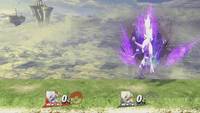
|
|---|
Taunts[edit]
- Up taunt: Closes its eyes and folds its arms as it telekinetically spins around on the spot while laughing ominously. Resembles the animation Mewtwo performs while using a physical move in the Pokémon Stadium games.
- Side taunt: Surrounds itself in a flame-like aura of dark energy, similarly to Lucario's up taunt.
- Down taunt: Mewtwo's eyes shine briefly before it turns to face the screen. While facing the screen, it thrusts its arm forward to emit a small spark of dark energy.
| Up taunt | Side taunt | Down taunt |
|---|---|---|
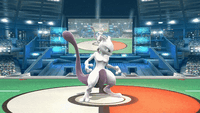
|
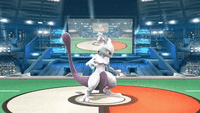
|
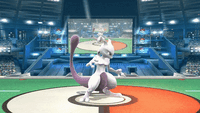
|
Idle poses[edit]
- Motions toward itself with its arm further from the screen.
- Draws its arms towards itself and strikes a pose.
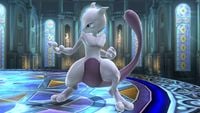 |
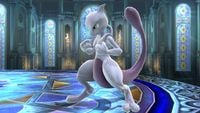
|
|---|
Crowd cheer[edit]
| Cheer (English) | Cheer (Japanese) | Cheer (Spanish) | Cheer (French) | Cheer (German/Italian) | |
|---|---|---|---|---|---|
| Cheer | |||||
| Description | Mewwww-two! | Mewwww-two! | Mewwww-two! | Allez Mew - two ! | Mewwww-two! *claps 3 times* |
Victory poses[edit]
- Turns its back to the screen and looks back over its shoulder, saying "Hmm..." In the Japanese version, it says "私はなぜここにいるのか...?" ("Why am I here?")
- Thrusts its hand forward, emits dark energy from its body, and growls. In the Japanese version, it says "私はまけるわけにはいかない!" ("I can not lose!")
- Spins once and then poses while laughing ominously and emitting a flame-like aura of dark energy around itself. In the Japanese version, it says "愚かな!" ("Foolish!")
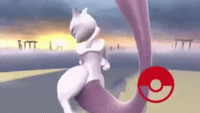 |
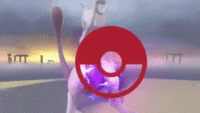 |
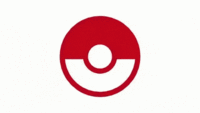
|
|---|
In competitive play[edit]
Most historically significant players[edit]
See also: Category:Mewtwo players (SSB4)
Abadango - The best Mewtwo player of all time, primarily playing the character in 2016 and 2017 and as a co-main alongside Bayonetta from 2017 onward, as well as one of the best Japanese players of all time, ranking 13th on the PGR 100. He is the only Mewtwo player to win a major, doing so at Pound 2016.
MagiMagi - The best Mewtwo player in Europe best known for his run to 9th at Super Smash Con 2018 defeating CaptainZack, ANTi, and Eon. He also has wins over many of Europe's best players, including defeating Glutonny to place 2nd at Ys and defeating S1 and IxisNaugus twice to place 3rd at Albion 2.
Rich Brown - First known for defeating Dabuz to place 13th at Paragon Los Angeles 2015 and became the second-best Mewtwo player in North America in 2016 and 2017, with results such as 3rd at Little Big House 2 defeating Nairo and Kameme; 5th at 2GGT: Abadango Saga defeating CaptainZack; and 17th at Super Smash Con 2016 defeating Abadango. His activity and results nationally declined in 2018, but he was still ultimately ranked 52nd on the PGR 100.
SDX - The second-best Mewtwo player in North America in 2018, making his mark on the competitive scene in the tail end of competitive Smash 4 with performances such as placing 5th at The Big House 8 defeating Elegant and Mistake, 7th at 2GG: Hyrule Saga defeating Light and Kameme, and 9th at Get On My Level 2018 defeating Ally and WaDi. Despite his relatively-late debut on the national scene, he was ranked 45th on the PGR 100.
WaDi - The second-best Mewtwo player of all-time and the highest-ranking solo-Mewtwo player on the PGR 100, ranking 26th. Alongside wins over many of the game's best players, he has placed top 8 at many majors, including placing 2nd at EGLX 2018, 5th at both Super Smash Con 2017 and 2GGC: MkLeo Saga, and 7th at 2GGT: Abadango Saga.
Tier placement and history[edit]
Mewtwo's return to the series was initially met positively, as players had soon noticed its increased mobility, power and range, which in turn led to it being perceived as a mid-tier character. However, players also lamented the nerfs to Mewtwo's already poor endurance. When coupled with other issues that became more prominent over the time, players gradually started to agree that Mewtwo's improved offense was not sufficient enough to compensate, in a case similar to Ike. While these drawbacks saw Mewtwo's perception plummet, some players insisted that Mewtwo was underrated and that critics were too focused on its frailty to see its positive traits. As time went on, Mewtwo received buffs via game updates, most notably to its mobility and aerials. These improvements led it to be ranked 37th on the first tier list, which established it as a low-tier character like in Melee.
After Mewtwo's dashing speed was further increased in update 1.1.5, players such as Abadango, Rich Brown and WaDi began placing higher with it in tournaments, and showed that its powerful offensive potential now outweighed its defensive shortcomings. This resulted in a drastic improvement in Mewtwo's perception within the community, which was reflected in it being ranked 10th on the second tier list. This new ranking was notable for not only reassessing it as a top-tier character but for also being the largest tier rise between the first and second tier lists. Mewtwo's continued success led to it being ranked 9th on the third tier list, which reaffirmed its status as a top-tier character.
Despite WaDi achieving some very notable results, such as placing 5th at Super Smash Con 2017 and 2GGC: MkLeo Saga, Mewtwo's tournament presence has slightly waned since then, owing to players becoming more capable of exploiting its weaknesses. This was further compounded by its best player, Abadango, picking up Bayonetta as a co-main and using her more often. Due to its slightly worsened perception and results, Mewtwo has dropped to 10th on the fourth and current tier list. Some smashers, however, like ZeRo and ANTi believe that it should be ranked slightly higher.
In Solo Modes[edit]
All-Star Mode[edit]
In All-Star Mode, Mewtwo is fought in Stage 5 in the 3DS version or Stage 3 in the Wii U version if it has been downloaded alongside Pikachu, Ness, Jigglypuff, Sheik, Ganondorf, Charizard, Diddy Kong, and Cloud.
Congratulations Screens[edit]
3DS[edit]
Wii U[edit]
Trophies[edit]
Mewtwo's fighter trophy is obtained by clearing Classic Mode as Mewtwo. Its alternate trophy is obtained by clearing All-Star Mode as Mewtwo in the 3DS version or booting up the game after downloading Mewtwo in the Wii U version. The Psystrike trophy is obtained only in the Wii U version by clearing All-Star Mode as Mewtwo.
- Mewtwo
 Mewtwo puts its psychic powers to great use in this game. Not only does it have floaty jumps, but its telekinesis gives its attacks extra reach and its throws added power. However, its light body makes it easy to launch, so if you're willing to take the risk of getting in close, it might just be worth it!
Mewtwo puts its psychic powers to great use in this game. Not only does it have floaty jumps, but its telekinesis gives its attacks extra reach and its throws added power. However, its light body makes it easy to launch, so if you're willing to take the risk of getting in close, it might just be worth it! Mewtwo puts its psychic powers to great use in this game. Not only does it have floaty jumps, but its telekinesis gives its attacks extra reach and its throws added power. However, its light body makes it easy to launch, so if you're willing to risk getting in close, it might just be worth it!
Mewtwo puts its psychic powers to great use in this game. Not only does it have floaty jumps, but its telekinesis gives its attacks extra reach and its throws added power. However, its light body makes it easy to launch, so if you're willing to risk getting in close, it might just be worth it!: Pokémon Red & Pokémon Blue (09/1998)
: Pokémon X & Pokémon Y (10/2013)
Mewtwo puts its psychic powers to great use in this game. Not only can it float in midair, but its telekinesis gives its attacks extra reach and its throws added power. However, its light body makes it easy to launch, so if you're willing to take the risk of getting in close, it might just be worth it!
: Pokémon Red/Blue (10/1999)
: Pokémon X/Y (10/2013)
- Mewtwo (Alt.)
 Mewtwo's Confusion side special not only lets you repel projectiles—it also reflects the damage back on your opponent. Its down special, Disable, stuns an enemy for longer the higher its damage is. As it works by having Mewtwo glare at its foe, this only works if they make eye contact.
Mewtwo's Confusion side special not only lets you repel projectiles—it also reflects the damage back on your opponent. Its down special, Disable, stuns an enemy for longer the higher its damage is. As it works by having Mewtwo glare at its foe, this only works if they make eye contact. Mewtwo's Confusion side special not only repels projectiles—it also reflects the damage back on your opponent. Its down special, Disable, stuns an enemy for longer the higher its damage is. Disable only works on foes that are facing Mewtwo.
Mewtwo's Confusion side special not only repels projectiles—it also reflects the damage back on your opponent. Its down special, Disable, stuns an enemy for longer the higher its damage is. Disable only works on foes that are facing Mewtwo.: Pokémon Red & Pokémon Blue (09/1998)
: Pokémon X & Pokémon Y (10/2013)
Mewtwo's Confusion Side Special not only lets you repel projectiles, it also reflects the damage back on your opponent. Its Down Special, Disable, stuns an enemy for longer the higher its damage is. As it works by having Mewtwo glare at its foe, this only works if they make eye contact.
: Pokémon Red/Blue (10/1999)
: Pokémon X/Y (10/2013)
- Psystrike
Mewtwo's Final Smash starts as Mewtwo Mega Evolves into Mega Mewtwo Y. It then fires a huge psychic projectile that penetrates enemies and obstacles. This projectile doesn't do any damage, but it freezes every foe it hits in place. They can even be frozen midjump! Afterward, every foe hit with the projectile will take a powerful psychic hit to the head.
Mewtwo's Final Smash starts as it Mega Evolves into Mega Mewtwo Y, then fires a huge psychic projectile that penetrates enemies and obstacles, but doesn't do any damage. It's only afterwards that every foe the projectile hit freezes in place and takes a powerful psychic hit to the head. They can even be frozen mid-jump!
Mewtwo also has a non-fighter trophy as part of the base game that can be purchased in the Trophy Shop for 500G (or 10 Play Coins) in the 3DS version or 1500G in the Wii U version.
- Mewtwo
Created from modified Mew DNA, Mewtwo was designed to be the ultimate Pokémon. It didn't take on any of Mew's kinder traits and only uses its intelligence to destroy its enemies. Or...so it seems. Perhaps it just feels frightened or even tormented, and that's why it lashes out. Whatever the reason, Mewtwo is not to be messed with.
: Pokémon Red & Pokémon Blue (09/1998)
: Pokémon FireRed & Pokémon LeafGreen (09/2004)
Created from modified Mew DNA, Mewtwo was designed to be the ultimate Pokémon. It didn't take on any of Mew's kinder traits, and only uses its intelligence to destroy its enemies. Or...so it seems. Perhaps it just feels frightened or even tormented, and that's why it lashes out. Whatever the reason, Mewtwo is not to be messed with.
: Pokémon Red/Blue (10/1999)
: Pokémon FireRed/LeafGreen (10/2004)
Alternate costumes[edit]

| |||||||

|

|

|

|

|

|

|

|
Trailer[edit]
[edit]
Gameplay Trailer[edit]
Gallery[edit]
The differences between Mewtwo's models for Super Smash Bros. for Nintendo 3DS and Super Smash Bros. for Wii U. The latter version's model was used for Mewtwo's official artwork on Club Nintendo prior to its official trailer.
Mewtwo's amiibo.
Mewtwo's unlock notice in Super Smash Bros. for Wii U after downloading it from the Nintendo eShop.
Using its forward throw on Luigi.
Using its down smash on Ike.
Alongside Mew.
Using Disable on Little Mac.
Mewtwo Mega Evolving into Mega Mewtwo Y as part of its Final Smash.
Using its forward aerial on Toon Link.
Using its forward tilt on Greninja.
Trivia[edit]
- During development of the game, an appearance of Mewtwo's Mega Evolution was reportedly considered by Masahiro Sakurai.[6]
- Mewtwo's artwork for this game resembles its artwork for Pokémon FireRed and LeafGreen Versions, although mirrored.
- Mewtwo is the only playable Pokémon in Super Smash Bros. 4 to not readily appear in any capacity in Pokémon Sun and Moon. Instead, it must be transferred over via Pokémon Bank. Charizard and Greninja, while unobtainable under normal gameplay conditions, appear as a Ride Pokémon and a member of Red's team, and as a gift Pokémon from Pokémon Sun and Pokémon Moon Special Demo Version, respectively.
- However, Mewtwo appears in Pokémon Ultra Sun and Ultra Moon, and is obtainable in an Ultra Wormhole along with many other Legendary Pokémon.
- Mewtwo is the second of three Super Smash Bros. Melee characters to return to the series in SSB4 after being absent from Super Smash Bros. Brawl, succeeding Dr. Mario and preceding Roy.
- However, there are scrapped files for all three of these characters in Brawl, suggesting that they were planned to make a reappearance there as well.
- Mewtwo's pose in its official art for SSB4 is nearly identical to its pose in its official art for Melee.
- As possible callbacks to Melee, Mewtwo has only one voice clip for when it is KO'd, and only the Japanese version of SSB4 features its victory quotes consisting of spoken dialogue.
- Mewtwo folds its arms in numerous instances. It does so while using its up tilt, up taunt, or a Hammer; during its defeated/No Contest and screen KO's animations; and when it is asleep, teetering, or helpless.
- Prior to update 1.0.7, it was possible to access glitched versions of Mewtwo's custom moves via a glitch involving shared Mii Fighters. Most of these crash the game, with the exception of both variations of Confusion, a non-functional version of Disable that renders Mewtwo helpless, and a version of Disable which zooms the camera in on Mewtwo and temporarily slows down time, all of which have limited functionality. It is unclear whether the glitch involved accessing custom moves that were incomplete, or data not intended for use of custom moves. One of the variations of Mewtwo's glitched custom Confusion is very similar to the soul breaker glitch. It is speculated that these were unfinished custom moves and that DLC characters were intended to have custom moves. While the glitch was removed by update 1.0.7, it was still possible to view replays containing these special moves prior to update 1.0.8.
- Mewtwo is the only veteran DLC character with a new voice actor, and the only character in SSB4 to speak only in the Japanese version.
- Mewtwo is the first DLC character to have been downloadable for free. It is also the only DLC character who does not share equipment types with any other DLC character.
- As of SSB4, Mewtwo is the only character whose falling speed has remained unchanged.
- Mewtwo's non-fighter trophy model has very slightly different features from its playable character and fighter trophy's models. It has a slightly smaller head, slightly smaller eyes, a thicker and slightly longer tail, slightly smaller hands, a more vibrant shade of violet for its midsection, tail, and eyes, and its texture has a satin finish instead of a glossy finish. As a result, it resembles the Mewtwo from the first Pokémon movie, whereas Mewtwo's playable character and fighter trophy's models are virtually identical to its appearance in Pokédex 3D Pro.
- Mewtwo and Lucario are the only playable Pokémon in SSB4 who do not emerge from a Poké Ball as part of their on-screen appearances.
- Although Mewtwo's Final Smash involves Mega Evolution, it differs from Charizard and Lucario's in a few distinct ways. Mewtwo's is used for a single attack and renders it both invincible and stationary for its duration, whereas Charizard and Lucario's function as transformations that grant improved offense, mobility, and armor for their durations. Mewtwo's Final Smash is also referred to by its primary attack's name of Psystrike, instead of simply as "Mega Evolution".
- In Mewtwo's reveal trailer, Ness is shown stalking Mewtwo while holding a Master Ball, as well as using a Genesect from a [Poké Ball] against it. This is a reference to standard Pokémon games, where the player character is often young and tasked with catching every Pokémon.
- The Master Ball is many players' choice of Poké Ball against Legendary Pokémon, such as Mewtwo.
- Additionally, EarthBound and Pokémon were both developed by Creatures Inc. (then known as Ape Inc.).
- Despite being a veteran, Mewtwo was referred to as a "new fighter" when it was revealed to be DLC.
References[edit]
- ^ Wii U - Super Smash Bros. for Wii U 50-Fact Extravaganza
- ^ a b Nintendo Direct 4.1.2015
- ^ Super Smash Bros. Club Nintendo Promotion
- ^ a b c d The misconceptions about Mewtwo's hurtbox end here
- ^ a b Kurogane Hammer on Twitter: "Mythbusters: Mewtwo's tail doesn't have a hurtbox at all except at the very base of it. 2D stages don't magically make it have one."
- ^ Sakurai Considering Mewtwo for Next Smash Bros. Games
| Fighters in Super Smash Bros. 4 | |
|---|---|
| Veterans | Bowser · Captain Falcon · Charizard · Diddy Kong · Donkey Kong · Dr. Mario · Falco · Fox · Ganondorf · Ike · Jigglypuff · King Dedede · Kirby · Link · Lucario · Lucas · Luigi · Mario · Marth · Meta Knight · Mewtwo · Mr. Game & Watch · Ness · Olimar · Peach · Pikachu · Pit · R.O.B. · Roy · Samus · Sheik · Sonic · Toon Link · Wario · Yoshi · Zelda · Zero Suit Samus |
| Newcomers | Bayonetta · Bowser Jr. · Cloud · Corrin · Dark Pit · Duck Hunt · Greninja · Little Mac · Lucina · Mega Man · Mii Fighter (Mii Brawler · Mii Gunner · Mii Swordfighter) · Pac-Man · Palutena · Robin · Rosalina & Luma · Ryu · Shulk · Villager · Wii Fit Trainer |





